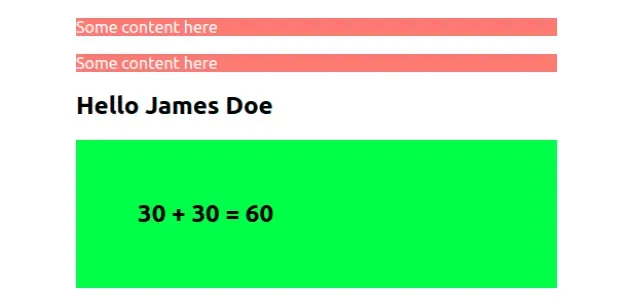React 中的字符串插值(附示例)
String Interpolation in React (with examples)
在 React 中使用模板文字进行字符串插值,例如
<div className={text-white ${myClass} }>。模板文字用反引号分隔,并允许我们使用美元符号和花括号${expression}
语法嵌入变量和表达式。
import './App.css'; export default function App() { const myClass = 'bg-salmon'; const name = 'James Doe'; const num = 30; return ( <div> <div className={`text-white ${myClass}`}>Some content here</div> <br /> <div className={`text-white ${'hi'.length === 2 ? 'bg-salmon' : ''}`}> Some content here </div> <h2>Hello {name}</h2> <h2 style={{ padding: `${num + num}px`, backgroundColor: 'lime', }} > 30 + 30 = {num + num} </h2> </div> ); }
这是示例的 CSS。
.bg-salmon { background-color: salmon; } .text-white { color: white; }

我们可以使用
模板文字
在字符串中插入变量。
美元符号和花括号语法允许我们使用被评估的占位符。
<div className={`text-white ${myClass}`}>Some content here</div> <div className={`text-white ${'hi'.length === 2 ? 'bg-salmon' : ''}`}> Some content here </div>
The curly braces we wrapped the template literal in mark the beginning of an
expression that has to be evaluated.
When you want to render a variable or expression in your JSX code, you have to
wrap it in curly braces.
<h2>Hello {name}</h2>
You can also use template literals outside of your JSX code.
const num = 50; const result = `${num + 50} percent`; console.log(result); // 👉️ 100 percent
By default, the template literal concatenates the parts into a string.
You can also interpolate variables in multi-line strings using a template
literal.
const color1 = 'red'; const color2 = 'blue'; const poem = `roses are ${color1} violets are ${color2}`; console.log(poem); // 👉️ roses are red // 👉️ violets are blue
This is very useful because we don’t have to add a newline character on each
line, as opposed to when concatenating strings.
You can even call functions in template literals.
import './App.css'; export default function App() { const subtract = (a, b) => { return a - b; }; const myClass = 'bg-salmon'; const num = 30; return ( <div> <div style={{fontSize: `${subtract(60, 20)}px`}} className={`padding-${subtract(100, 80)} text-white ${myClass}`} > Some content here </div> </div> ); }
Here’s an example of using the
ternary operator
with template literals.
const color1 = 'blue'; const color2 = 'red'; const result = `${color1.length > color2.length ? color1 : color2}`; console.log(result); // 👉️ blue
The ternary operator is basically an if/else statement. The part before the
question mark gets evaluated and if it returns a truthy value, the operator
returns the value before the colon, otherwise it returns the value after the
colon.
import './App.css'; export default function App() { return ( <div> <div className={`text-white ${'hi'.length === 2 ? 'bg-salmon' : ''}`}> Some content here </div> </div> ); }
The ternary operator in the example checks if the length of the string hi is
equal to 2 and if it is, it returns the string bg-salmon, otherwise an empty
string is returned.
You can also use the logical OR (||) and logical AND (&&) operators in a
template literal.
const num1 = 0; const num2 = 100; const result = `${num1 || num2}`; console.log(result); // 👉️ 100
The logical OR (||) operator returns the value to the left if it’s truthy,
otherwise it returns the value to the right.
下面是对模板文字使用逻辑与 (&&) 运算符的示例。
const bool = true; const str = 'hello'; const result = `${bool && str}`; console.log(result); // 👉️ hello
逻辑与 (&&) 运算符如果为假,则返回左侧的值,否则返回右侧的值。
ext.jpg)